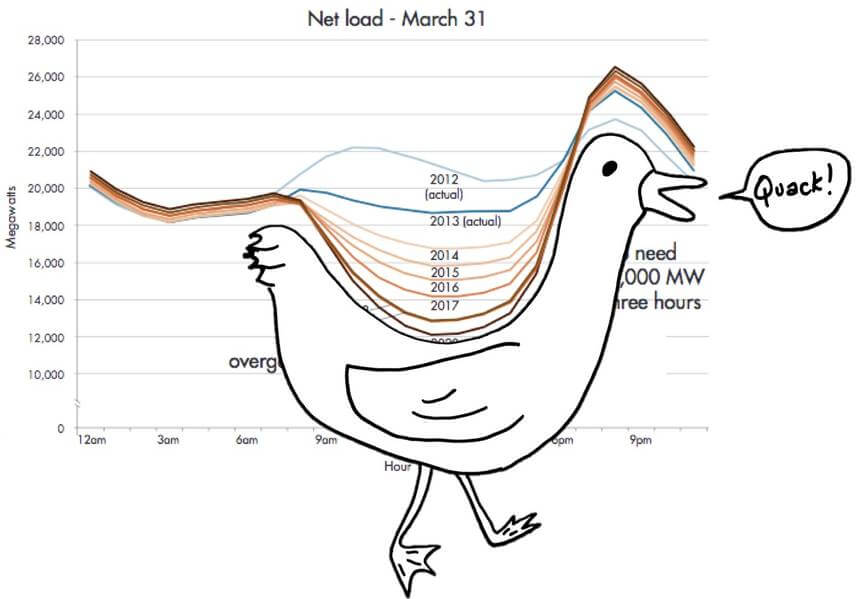From 2GreenEnergy Intern Kevin Kuttumkal: Additional Electric Vehicles Can Reduce California’s “Duck Curve”

In order to make full use of this vast amount of clean, solar energy, the CPUC (California Public Utilities Commission) has mandated that the ‘big three” utilities, San Diego Gas and Electric, Pacific Gas & Electric, and Southern California Edison procure and implement 1.3 GW of energy storage by 2020.
The ever-increasing number of electric vehicle (EVs) on the roads coming back to recharge batteries at the end of the day can aggravate the strain on the grid by adding to the fluctuation of demand. However, a “smart” use of EVs offers a way to fill in some of the storage void using the EVs’ batteries.
Using smart technology, EVs can charge during peak solar production hours and effectively store the energy in the battery, which would otherwise either be sold back to the grid or need to be curtailed. The gap in net demand would be reduced; in fact, if all EVs in the state were to follow suit, it would be equivalent to adding 1 GW of storage according to the Department of Energy’s Lawrence Berkeley Laboratory.
We also need to consider “vehicle-to-grid,” or “V2G,” where batteries are able to charge and discharge energy back into the grid. EVs with a mix of V2G and conventional (one-way) batteries would be able to shave off up to 5 GW of daytime over-generation and evening peak demand.
Another interesting discovery is that if 30% of workplaces offered EV charging, and 60% home owners let their V2G EVs provide power back to the grid, this would result in a savings of approximately $60 billion that would have been required in energy storage investment.
By 2025, there will be 500,000 fully electric vehicles expected be on the roads of California, along with one million plug-in hybrids, all of which will help alleviate the duck curve issue. The cost to implement an initiative with EVs would cost very little, thanks to smart grid technologies.

That is a really smart use of electric vehicles! The only issue I see is that homeowners will probably see this as an inconvenience because they would prefer to charge their cars when they want instead of midday!
Hi Kevin,
I hope you enjoy your time with Craig, you couldn’t have picked a better mentor 🙂
I hate to be negative, but EV owners are consumers. As a rule consumers, even early adopters, aren’t known for their altruism or consistency.
I’m an EV owner on two continents. (I’m a very early EV owner,I’ve also been a major shareholder, financier and director of a specialist EV business for over twenty years (so I know a little about the subject).
Ev owners know each battery charge and discharge affects the life of the battery. Susan is quite right, EV owners will only charge in accordance with their own circumstances and convenience.
Sadly, although your suggestions may have a good deal of merit in theory, you many find your findings unpopular with the EV industry itself.
The industry (which is really struggling)may be alarmed such a plan would prove a disincentive for EV adoption.
Currently 337,482 EV’s have been sold in California, but that figure doesn’t include attrition figures and includes some classes of NEV’s and plug-in hybrids. The State of California is very optimistic, Californian projections don’t include any allowance for how sales will be affected when Federal subsidies and Tax credits begin to terminate or phaze out. The experience in other states reveals a rapid decline in EV sales.
Exxon, Shell and Chevron do not expect any dramatic rise in domestic gasoline prices over the next decade, so EV adoption can’t expect any assistance from that quarter.
I may be wrong, (I hope I am) but I think any prospect of V2G energy contribution lacks feasibility.
There are options for making smart charging and v2g more attractive.
Technical considerations will limit the number of dumb EV chargers on a particular sub-station, so it is likely to become mandatory for smart chargers to be installed – capable of being throttled back if peak demand would otherwise be too high.
Special tariffs will almost certainly be offered soon to EV users opting for smart chargers set up to allow the utility operator the flexibility to operate the throttle on the charger so the owner plugs in as normal, and has a full battery next morning with the grid operator deciding when and how fast to charge the car, and some jurisdictions such as the UK are already looking at making smart EV chargers mandatory.
There could always be an override button for emergencies where the EV owner agrees to pay 3 or 4 times the normal EV charging tariff to guarantee charging in a hurry.
Concur. Please see: http://www.2greenenergy.com/2018/08/11/vehicle-to-grid-3/
For V2G the EV owner could be paid a standby fee for availability, and a good rate for occasional export when the grid is suffering
E.G just after sunset on the hottest day of the year when there also happens to be no wind! Whereas typical wholesale power prices might be 40 to 50 USD per MWh, spot market prices can occasionally spike well above 1000 USD or above a dollar per kWh. When this happens, the chance to sell 50 kWh to the grid for 50 USD in the evening and buy them back after midnight for 5 USD Should be attractive to many users.